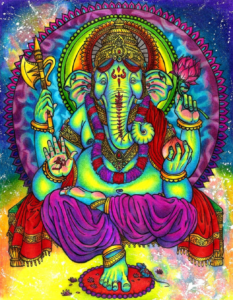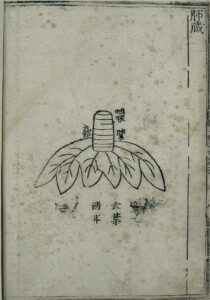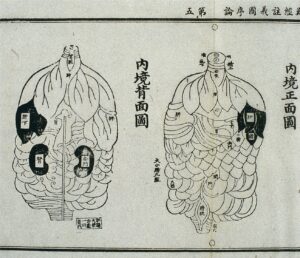Never miss an update!
Subscribe to Ambika’s Blog and receive news straight into your inbox!
Thank you for joining my newsletter
Check your email to confirm and receive a gift!

ॐ गं गणपतये नमः
I am often asked questions by clients and students that range from, “What is my purpose?” to “When will I find love?” What I wish you were asking me is, “How can I feel good just being me?” or “How can I quiet my chattering thoughts that push me towards external desires?”
What I want you to know is that all of the answers are in you. I do end up unraveling the thick fibers of belief systems that layer in netting, obscuring an individual’s view of their true being-ness and behavior. It is my intention to cast a beam of light upon the necessity to focus on building self-esteem and self-love. When my clients take this in I watch as it infuses and awakens them from the amnesia that has been convincing us, imagining that we are separate from each-other.
We Yogi’s believe that there is no separation. Why is it then, that our connection to the unified mind continues to sling weapons of doubt through our own incessant practice of autosuggestion. These mix with prarabdha karma प्रारब्ध कर्म, the dance-card of tests and lessons we agreed to work on for the elevation of soul prior to popping out of our mothers’ wombs after renting them for nine months. These confusions are then sprinkled with self-decimation that destroys strength levels and fools us with delusion.
Science is catching up little by little however a great deal of the antidote still remains hidden from us. There is so much poison being placed in the awareness paths of humanity that just as in a battle of good and evil—the demonic forces can often appear to be winning.
In the epic poem, The Mahabharata महाभारतम्, an enlightened conversation with the source of all that is, takes place and answers the many questions we human beings ask about: What are we doing here? What is our purpose, and what is our Dharma धर्म —our true nature?
What I have learned from the nature spirits, the devas of the plant world, the sturdy spirits of the rocks and precious gems is that the only way to hear them is to change the incessant negative chatter of the mind into positive thought. But how can we do this? How can we think the opposite?
My quest to quiet the mind is my peace mission. You can read more about this in my article about my quest to tame the mind.
Maybe you have tried prayer or positive affirmation. You might have listened to mind-entertaining guided meditations or have tried hypnosis. I have a guided meditation podcast where you can listen to me read this article linked at the top of this page. You can use it to find sleep or take a much needed break in the middle of the day. Perhaps you have taken a ride on one of Deepak Chopra and Oprah’s 21 day meditation challenges?
Back in 2013 I had made the decision to continue my research of sound and the use of one’s own voice to quieten the mind. This inspired me to make a PhD challenge which was accepted and it is to create curriculum to teach meditation to people so that they know that they are in this divine state of being. When Oprah and Deepak Chopra launched their first of what would become a successful series of 21 day meditation challenges they chose to use sacred chants from the ancient language of Samskrutham संस्कृतम् — what we call Sanskrit in English.
I was instructed at the time to follow this global phenomena by my professor and to report back about what was being used as tools for the participants. The experiences focused on a variety of wellness topics ranging from self-love to manifestation. Each day recipients received encouraging thoughts by Oprah followed by a new mantra presented with a little explanation from Chopra. He would then lead a meditation with background music and then bring the listeners back to the present moment with the sound of chimes and a few closing thoughts.
As a master’s student studying the language of Sanskrit, I was trained to understand the potency and power of this ancient mother tongue. In addition, as an astrologer I was also made aware of the importance of proper timing that must be engaged and used to guide one to choose which mantra would be the best to use in any given moment.
My professors were very particular and taught me the importance of perfect pronunciation. They remain valued friends and teachers as I continue to study, publish, and teach about this topic.
When I questioned my one of my professors, about the mispronunciation presented in the meditation challenge style that I had encountered — my esteemed professor said this to me:

Imagine that you are standing on the threshold of a door. It is an obstacle you wish to get through. On the other side is great healing or knowledge that you crave.In your hand is a ring of keys.

One of these could potentially open up that mystical door. The transcendence you hunger for is on the other side of that door and the proper mantra can open it. But when you mispronounce the mantra that you think is correct or use it at the wrong time, you will never be able to get that door open.
Instead, you will find yourself standing there jiggling the keys and that you will not be able to get one into the lock. You probably won’t even be able to find the right key. Mispronunciation can not only prevent entry — it can cause harm.
Ancient cultures have known the healing power of sound for centuries. Some of the great books speak of a sound that began what we perceive as this existence.
I have been taught that the transcendent nature of properly pronouncing the word Samskrutham activates the pineal gland in such a way, that it can urge a release of the sweet nectar known as Ojas ओजस्. This mysterious essence translates to splendor, vitality, power, luster, appearance, and bodily strength. You can think of Ojas as the container that holds your happiness. It is the purest essence of Kapha Dosha one of the Ayurveda qualities of the body’s humors. In the physical body, Ojas is related to the reproductive, hormonal, and cerebrospinal fluids.
A sound just like a smell, has the ability to induce an instant reaction.
As a very young yogi, I learned in my study of the ancient Vedic text known as the Upanishads, that each sound from the Sanskrit alphabet resonates and vibrates with one of the corresponding fifty petals of the first six chakras. These profound energy centers are anchors for the layers that compose our bodies, minds, and spirits. Try to imagine these as multi-dimensional rather than thinking of them like flat discs or spinning wheels. Yes, in the two dimensional artwork we see chakras depicted as these flat disc-like lotus flowers, with each possessing specific numbers of petals. We can also see this idea expressed in the more modern Huangdi Neijing known as The Yellow Emperor’s Classic of Medicine in the modern translations of this text.

Yellow Emperor’s depiction of the lungs

A more modern Taoist depiction of the internal organs
Keep in mind that in the ancient times no autopsies were performed. Therefore, the culture did not know what the internal organs of the physical body looked like. Instead, they were imagined to be like multi petaled flowers, just as we see the chakras depicted. Could it be that this interpretation came by way of the ancient artwork of the chakras?
In the model of the chakra petals we focus upon the first six chakras. The first chakra, Muladhara Chakra मूलाधार चक्र, commonly called the root chakra, has four petals with four corresponding sounds. There are six sounds for the petals of Svadhishthana Chakra स्वाधिष्ठान चक्र, the second and ten held in the third, Manipura Chakra मणिपूर चक्र. Anahata Chakra अनाहत चक्र, the fourth in the location of heart center, carries 12 sounds and Vishuddha Chakra विशुद्ध चक्र, the fifth chakra of the throat has 16 petals. The Third eye, Ajña Chakra आज्ञा चक्र carries the final two in its scarab like shape. The seventh chakra, Sahasrara Chakra सहस्रार चक्र, known as the Crown Chakra has 1,000 petals. It is seen as the highest spiritual point and is beyond this reality. It is not included in this progression.

Thinking back to to the early attempts by Oprah and Chopra, I am sure that they had really good intentions when they set out to create their programs. What I encountered instead was a mishmash of mantras. When I reported this to my professor and about what I was experiencing he agreed with me that it was a toxic sound-soup of confusion. Before you become frustrated by this, please allow me offer you more explanation. Let us all keep in mind that we are only scratching a bit of the surface here. Yes, you may feel like you are going back to the beginning on some concepts that you already know. I do hope to shed light upon any you may have missed or forgotten. Vak-yoga वाक् योग is the Vedic name of Samskrutham. This adds another layer of mystery to a vast amount of knowledge.
Let us consider that when we want to open a path, alter a mood, or fully change our direction and the course of our progress upon life’s path, that it is a good idea to utilize the correct key and to be standing at the intended door at the best possible moment.
Back in history, the classical phrases and recommended articulations were first passed on by voice to voice, ear to ear and taught only in this way. This insured precision and patience. Tone, rhythm, and timing were carefully adhered to and are all key components. It was not until much later that any idea of written language was etched into palm leaves and even later from then, inked upon paper to capture these teachings.
In a seeming game of, Broken telephone, also known as, Whisper down the lane — a game that children play when one whispers a single phrase into the ear of the person sitting next to them, that is then passed on in the same fashion through the succession of ears. The practice and use of mantras has suffered the garbled outcome that happens at the end of the line. By passing information on, these sacred chants have become an indistinguishable garble of sounds resembling the confused phrases in the outcome of the whispering game. Let us all make an effort to be more mindful of this and continue to dive deeply into this knowledge.
In more recent times the practice of Vak-yoga वाक् योग has become known as Mantra-yoga मन्त्र यो. You can begin learning more about Vak-yoga, and the teaching brand of Yoga-Samskrutham University at their site.
To understand more about proper pronunciation of the language which is Vag-yoga वाग्यो please watch this video.
Now that we have identified that sacred mantras are composed of particular sounds with precise rhythms and intonations we must next honor the fact that there are parameters to follow as per specific times of day or night for their appropriate use.
The precision of timing giving guidance as to choosing a moment in time is measured by Jyotisha ज्योतिष, a sister discipline to Yoga. This is the science of light also known as astrology.
Yes, the timing of when to use any given sound-sequence holds tremendous importance. In order to make a choice demands a great understanding of the cosmic ruler-ship of each day, hour, and minute. Consideration must also be taken as to when the mantra is to be chanted and for what purpose. This is a science and not a free-flowing art-form. Each and every moment is ruled by specific energies of the universe.
To engage the full power of chanting a given mantra मन्त्र is to practice a transcendental form of Yoga. Therefore, these sacred utterances can be considered as mysterious invocations designed to shift the energy of the practitioner, those listening, the local environment, and the totality of the reality perceived around us. A mantra can therefore be imagined to be a form of supernatural manipulation as the adept yoga practitioners have the power to intervene with the cosmos, the fortunes of individuals, and Mother Nature’s processes. This is why it is very important to understand the full force of mantra-yoga and also why it can be mistaken for spell-casting and sorcery.
The Latin languages draw a great deal of sounds as well as grammar rules from the language of Sanskrit. We can see this in the etymology of many words in our own mother tongue of English. Given the principles that we are now decoding — I hope that we can agree — that every single shaping of syllables through the use of our very sacred Throat Chakra, is a potentially, powerful construction crew guided by the architect of thought. In addition, let us now realize that thought is a matrix Creatrix.
I invite you on a little journey to understand the formation of words. Imagine the first pop of an idea that is to become a spoken utterance. It happens so quickly that we do not even have time to grasp the moment — unless we are in the state of meditation. In order for this seed-idea to become a word, the original impression must dive down to the center of the heart-space — the chamber of the unstruck sound — to collect air from the lungs. Next, as it gains momentum this seed of thought becomes a single syllable, a fragment of or a complete thought to be expressed as a word.
The original spark travels onward to exit through the mouth. On its way there, the smooth tissue of the vocal cords strike together. This sets off a sequence of oscillations that could be full of grace and curative energy or disharmonious, causing distress. We can see the images of sounds through cymatics and it is explained beautifully in this video by Nigel John Stanford.
To understand the power of words, think of the photography experiments of the brilliant Dr. Masaru Emoto. He discovered the shapes of sounds which in the Vedas are referred to as Yantras यन्त् and these are expressed in his perfect, frozen sound images.

To learn more about this, I suggest reading two books by Dr. Emoto. One is entitled, The Hidden Messages in Water,
and the other, The True Power of Water. If you have not seen the film. What the Bleep Do We Know!?, you might find that interesting as well.
Another film I would like to suggest is, The Connected Universe, by Nassim Haramein. You can learn more about him and his work with the the Resonance Science Foundation.
Let us continue to follow the path of sound and consider that the sounds we make not only vibrate specific patterns of petals in the system of dynamic anchors strung together to form the chakra system but, that they also circulate back into our own heads through our physical ears thereupon influencing our bodies, minds, and spirits.
Now let’s ask ourselves, What occurs when a phrase has great intention and is mispronounced? It is my hope that your new gained knowledge is expanding your enthusiasm to create positive and correct sounds in any practice such as Mantra-yoga. Are you now finding that it makes sense that both thought and the formulation of sound effects everything?
Just in case you feel any discouragement, I have good news for you. We can begin to gently explore these concepts and to gain sensation from them, while avoiding any possible mistakes. This is a safe exploration of your body as an instrument of sound. To do this we are going to use vowel sounds along with specific consonants to safely produce bodily-felt sensations. This is going to give you the opportunity to prove and to know the full effects of your own voice.
Here is something you can try
Place yourself in a very quiet environment, free from electronics and distractions. This is preferably 30 feet from Wi-Fi and Bluetooth devices. To do the practice, place your body in a comfortable seated position with your back as straight as possible. If this is not available to you, it is okay to be in a reclining position as long as your breathing path is clear. It is most important to feel relaxed.
Begin by exhaling and then by taking a few very long, deep, cleansing breaths in and out through your nose. Once you feel that you are able to breathe deeply through your nostrils, progress to the next step.
Now, use the exhalation following one of your deep breaths in through your nose to make the sound टां Tum out through your mouth. This short vowel sound is pronounced, “uh” as in the words bug and cup. As you make this sound, allow your tongue to gently strike the soft tissue of the roof of the mouth, just behind the teeth rather than directly against the teeth. Repeat this for a minimum of four times. As you practice this, consciously become aware of the sound inside your body. Be neutral as you observe this and know that there is no right or wrong way to conduct this experiment. Continue to consciously experience the silence outside of your body during and after the moments when you produce the sound.
Let each sound to go out slowly and fully without force. Gently allow the sound to taper off on its own through natural nasalization as your lips close towards the end of the audible sound. Experience the trailing off of each sound like the tapering off of the ringing of a bell or a gong. Follow the dissipating sound as it disappears. After each sound ends, experience the totality of the silence. Allow yourself ample time to engage with the bubble of energy that this creates. Each time the sound ends, take in the next breath and continue in the sequence as many times as you desire. Each time becoming the witness of what is happening.
Next repeat the practice just as before with a new sound टं Tam. This vowel sound is, “ah” as in the word log or bog. Go through the same sequences as before with this new sound. Observe just as you did before, soaking in the effects and noticing the after sensations.
Listen to me read this article to you to hear pronunciations of all of the sounds and Sanskrit words.
It is very important to only use the sounds explained here for this particular experiment. Please do not use other sounds as this is a specific practice that originates from Yoga-Samskrutham University, and is an outreaching from Yoga teachings that are rooted in the Bhagavad Gita श्रीमद्भगवद्गीता and in the Patañjali पतञ्जलि writings.
Next, I invite you to write responses to the following questions in your journal
Analyze the state of your body before, during, and after the experience of each sound. Ask yourself if it is relaxed, tense, or neutral? What are your senses telling you? Pay close attention to any and all changes.
Likewise, monitor the sensations of your breathing and its capacity before, during, and after each experience. Ask yourself if it seems normal, slowed down, or modified in any way?
Further, observe the state of the mind before, during, and after each of these sound experiments. Ask yourself whether it seems more calm, peaceful, and joyous? Yogis see the mind as unified and therefor not possessed by an individual. We do not imagine ownership of the body either but I did not want to completely confuse you in this article.
Are you feeling inspired? It is my hope that we all become more aware of the words we use everyday in speech about ourselves, others, and our environment. Let us remember that pronunciation and timing matter especially when we expect to receive particular outcomes and when we are using the practice of Vak-yoga. The information I have shared with you here is just a launch-point for the vast science of sound, that is a substantial cornerstone supporting the philosophy of Yoga.
Would you like me to help your organization relax and feel more connected with greater levels of concentration? Engage me to speak at your next convention or event. Would you like to work with me one on one diving deep into the mystical art of meditation? You can message me and be sure to subscribe here to my blog. If you are ready now, book your appointment with me here.
Join me in my peace mission of teaching the world to meditate so that we can realize that we are all one.
Do you Love what I’m doing and want to help support my mission? You can Send me a love donation here. I really appreciate it.
A 90 min 1:1 focused session with me includes a detailed blueprint of your strengths, purpose, and true nature. Using my vital tools I give you a clear roadmap so that you can navigate the roadmap of life!
Are you ready to get focused and clear your mind? Book your appointment with me here.
Thank you for being a loyal reader and follower. It is mission of peace and your support of my work that keeps me going!
In Peace,
Ambika Devi
Helping you navigate the roadmap of life.
हरि ॐ तत् सत् Hari AUM Tat Sat
SHARE ON SOCIAL MEDIA